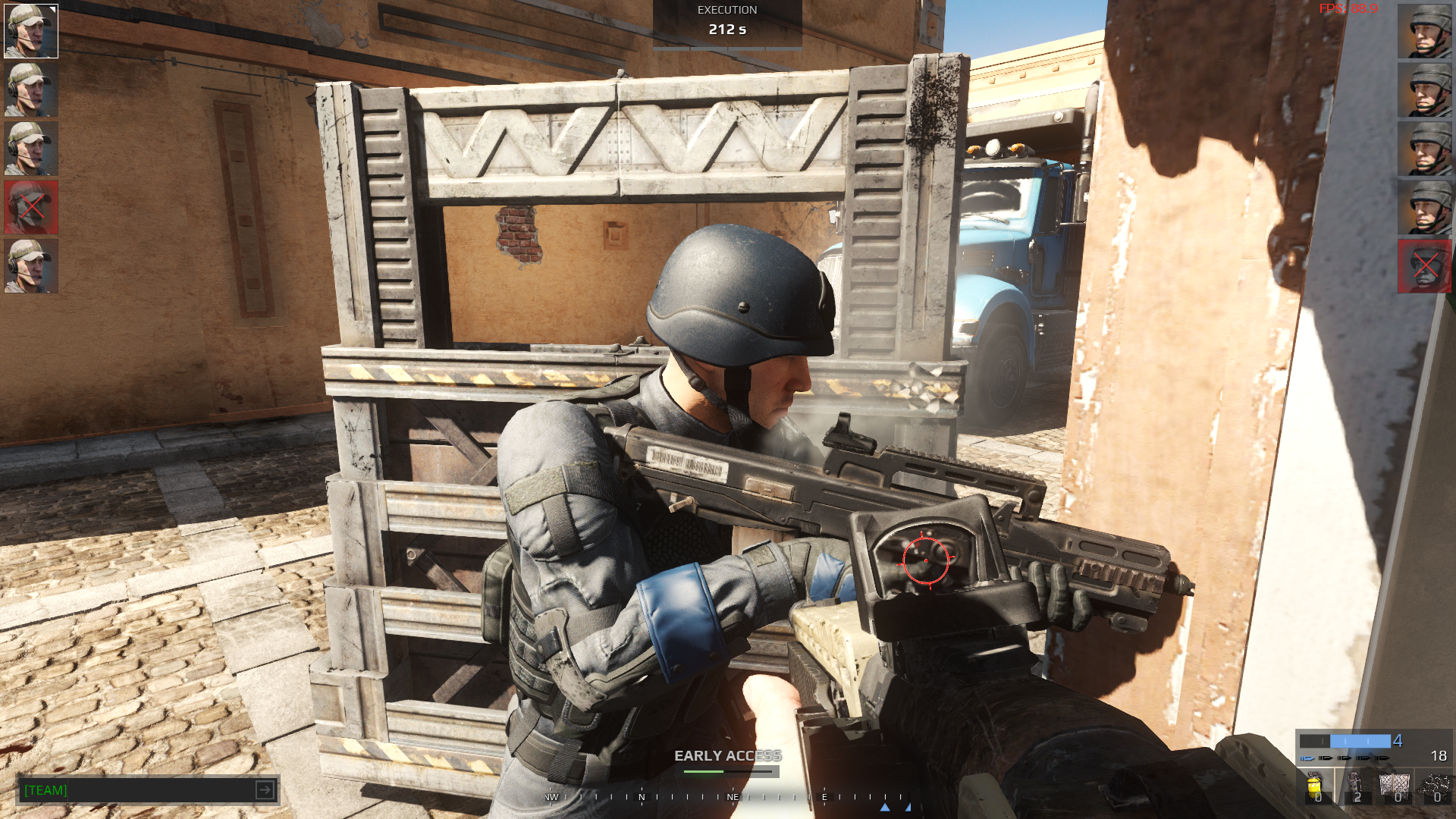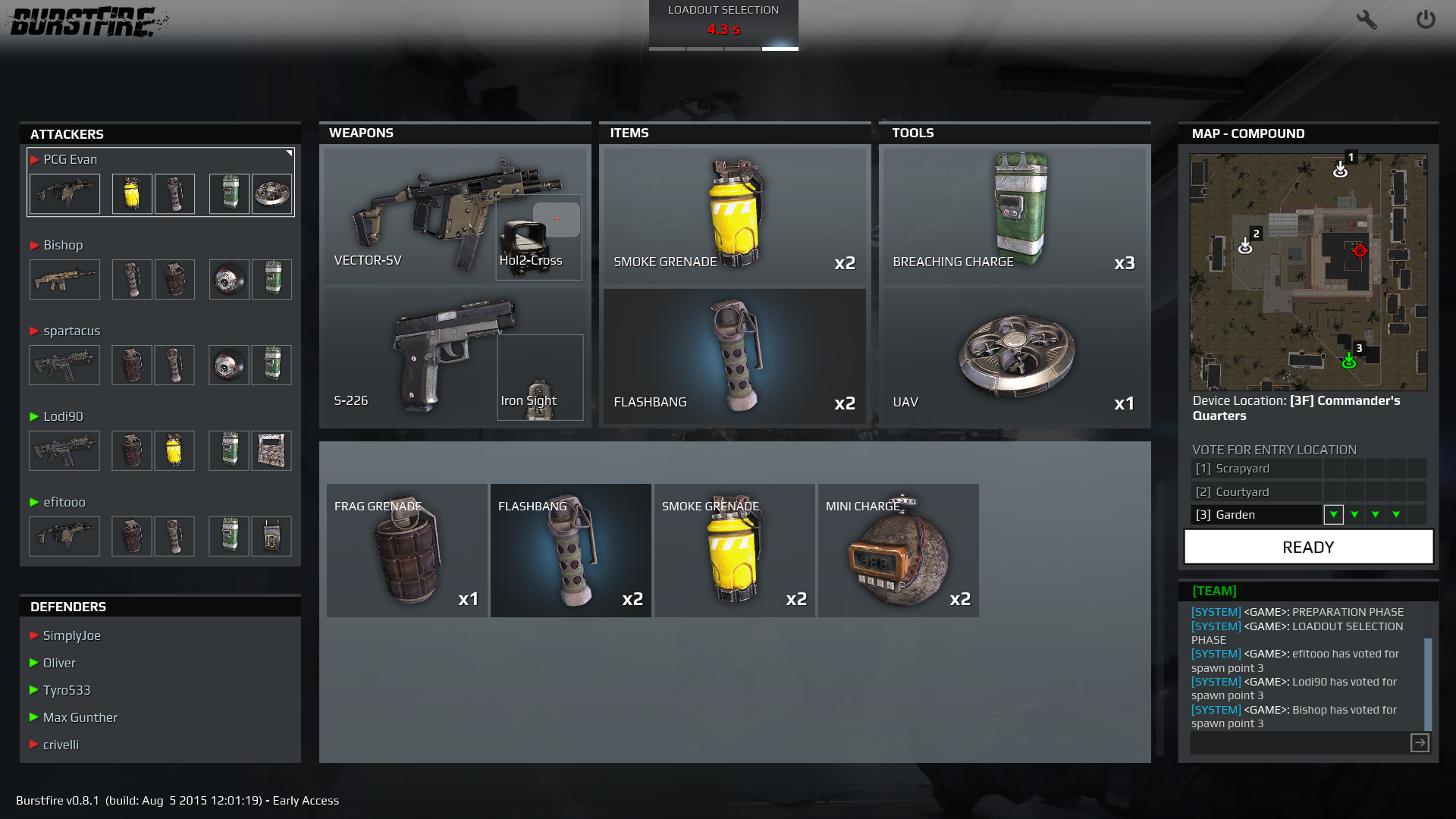A look at Burstfire, a hardcore tactical FPS made by four people

We write about FPSes each week in Triggernometry, a mixture of tips, esports, and a celebration of virtual marksmanship.
It’s a myth that multiplayer FPSes are only something that massive studios can cook up. Stuff like Overwatch and Battlefront will draw the biggest audiences, but there are plenty of interesting FPSes in development by scrappy teams. Reflex and Toxikk are ambitious stabs at retro arena FPS. Insurgency’s co-op AI hunt is delightfully low-key. Ratz Instagib is a railgun ballet made by one guy, and the more medium-sized MechWarrior Online continues to chug along. Even the team at Valve for CS:GO, currently the biggest FPS on PC, is rumored to be quite small.
Add to this pile Burstfire, a five-on-five tactical FPS that snuck onto Steam last week. Burstfire is the work of four Adhesive Games refugees, the creators of mech FPS Hawken, which itself famously began as a nine-person project.
Burstfire is surprisingly fun given the manpower behind it. There’s a lot of equipment and guns to tinker with, and weapon handling is a bit toylike but intuitive. I like that the time-to-kill is slightly longer than other games of its style. The maps are relatively intricate, multi-floor spaces with plenty of opportunities for lurking.
Looming over Burstfire, though, are some transparent similarities to Rainbow Six Siege. It’s not only the same style of game, but it shares Siege’s structure. Short rounds. Single life. There’s a pre-combat phase where the attacking side scouts the map with fast-moving ground drones while defenders deploy barricades, protective walls, and other defenses. Concrete patches in walls and floors mark demolition points. The map objective, a computer terminal, spawns at one of a few possible positions. Barbed wire placements deter movement and barricades block vision.

I know, because I met with them in San Francisco last month, that Nacho Games isn’t coy about the comparison to Siege. I generally reject the idea that being derivative merits some kind of automatic disqualification, as if most creative work isn’t in some way an iteration on the work of others before us. But in this case knowing that Rainbow Six Siege is on the horizon (due 2015, although Ubisoft’s record for delays is legendary) cast a long shadow over Burstfire for me. It’s like watching a perfectly decent movie set in a post-apocalyptic desert wasteland starring Logan Marshall-Green with the full knowledge that Mad Max exists, is wonderful, and stars his exact lookalike.
The more similar two things are, the more the gaps between them become apparent (I’m tempted to call this the “The Elder Scrolls Online effect”). It’s a distraction. And an unfortunate one, because Burstfire does hit some of the necessary fundamentals. As a tactical, room-clearing FPS, it has that sensation of being thrust into a sudden duel with another player, doing your best to estimate the number of bullets you’ve absorbed against the number you’ve deposited and trying to widen that margin. Entrances and breach points are angled in a way that makes it impossible for the defenders to cover every angle. The stats screen shows me a rundown of what body locations I hit enemies with, which even CS:GO doesn’t do, shamefully.

In other areas, Burstfire’s lack of polish really shows. The weapon optics are strangely opaque rather than holographic. The player models are detailed enough, but the absence of clambering animations and other model transitions make the animations that are in the game now appear even more rigid. When you spend an object like a barricade, there’s no “construct” animation—it simply teleports from your hands to the surface. Many of the basic surface textures lack cohesion or a sense of personality—I like the layout of Compound, a three-story house, but it neither feels seedy or charmingly normal, like the laundry room section of Siege’s house map. The proprietary engine that Burstfire sits atop of is clearly long in the tooth and being pushed to its limit.
Keep up to date with the most important stories and the best deals, as picked by the PC Gamer team.
It’s a shame, because I think Burstfire deserves an audience around it. If Siege wasn’t looming, we’d probably be hailing this as a return of the SWAT 4-style game. $15 is an aggressive price, but at the moment I’m more excited about Due Process, another indie breach-and-shooter that makes up for its modest budget by being a bit weirder, with low-fi art, randomly generated levels, and quirky ‘90s tech cluttering up the rooms you blow apart.

Evan's a hardcore FPS enthusiast who joined PC Gamer in 2008. After an era spent publishing reviews, news, and cover features, he now oversees editorial operations for PC Gamer worldwide, including setting policy, training, and editing stories written by the wider team. His most-played FPSes are CS:GO, Team Fortress 2, Team Fortress Classic, Rainbow Six Siege, and Arma 2. His first multiplayer FPS was Quake 2, played on serial LAN in his uncle's basement, the ideal conditions for instilling a lifelong fondness for fragging. Evan also leads production of the PC Gaming Show, the annual E3 showcase event dedicated to PC gaming.

